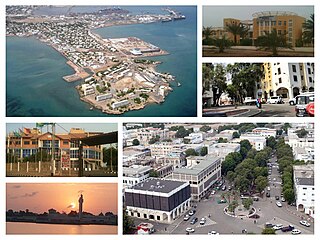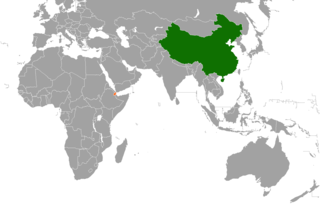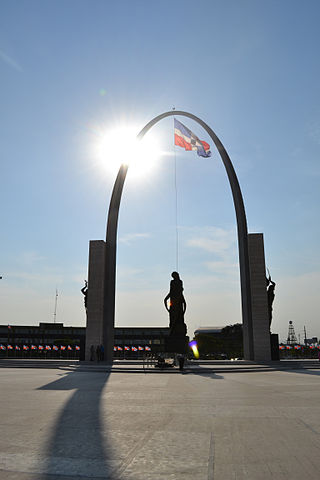
The Djibouti Armed Forces are the military forces of Djibouti. They consist of the Djiboutian National Army and its sub-branches the Djiboutian Air Force and Djiboutian Navy. As of 2018, the Djibouti Armed Forces consists of 20,470 ground troops, which are divided into several regiments and battalions garrisoned in various areas throughout the country. The Djibouti Armed Forces are an important player in the Bab-el-Mandeb and Red Sea.

The culture of the Republic of Djibouti is diverse, due to the nation's Red Sea location at a crossroads of trade and commerce.

Djibouti is the capital of Djibouti. It is located in the coastal Djibouti Region on the Gulf of Tadjoura.

The Djiboutian Music refers to the musical styles, techniques and sounds of Djibouti. The first major form of modern Djiboutian music began in the mid-1940s, when Djibouti was a part of the French Somaliland. Djiboutian music is characterized by poetry, so that listening to a Djiboutian song is first paying attention to its meaning. The artist rocks the listeners in the cheerfulness of the refrains and the turn of the sentences. Often sung by a couple, a song is played in the form of a sleight of hand between a man and a woman, one recounting his feelings and his love, even his passion for the other, until the other accepts or rejects this offer.

A liberty pole is a wooden pole, or sometimes spear or lance, surmounted by a "cap of liberty", mostly of the Phrygian cap. The symbol originated in the immediate aftermath of the assassination of the Roman dictator Julius Caesar by a group of Rome's Senators in 44 BCE. Immediately after Caesar was killed the assassins, or Liberatores as they called themselves, went through the streets with their bloody weapons held up, one carrying a pileus carried on the tip of a spear. This symbolized that the Roman people had been freed from the rule of Caesar, which the assassins claimed had become a tyranny because it overstepped the authority of the Senate and thus betrayed the Republic.

The El Hadj Hassan Gouled Aptidon Stadium is a multi-use stadium in Djibouti City, Djibouti. It is currently reserved mostly for football matches. The stadium has a capacity of hosting up to 20,000 fans. As of April 2007, the Stade has an artificial turf pitch courtesy of FIFA's Win in Africa development programme. It is currently the home ground of the Djibouti national football team. The stadium is home to many sports federations in Djibouti, including the Djiboutian Football Federation.

The Djiboutian Civil War was a conflict in Djibouti, lasting from 1991 to 1994 and resulting in thousands of fatalities. The uneven power sharing between the Issas and the Afars led to the Civil War that ravaged the country for three years.

The following outline is provided as an overview of and topical guide to Djibouti:

The Djiboutians are the native inhabitants of Djibouti, as well as the global diaspora of Djibouti. The country is mainly composed of two ethnic groups, the Somali and the Afar. It has many languages - though Somali and Afar are the most widely spoken ones, Arabic and French serve as the official languages. There is a small Djiboutian diaspora in North America, Europe, and Australia.

Djibouti, officially the Republic of Djibouti, is a country in the Horn of Africa, bordered by Somalia to the south, Ethiopia to the southwest, Eritrea in the north, and the Red Sea and the Gulf of Aden to the east. The country has an area of 23,200 km2 (8,958 sq mi).

Tourism in Djibouti is one of the growing economic sectors of the country and is an industry that generates 53,000 and 73,000 arrivals per year, with its favorable beaches and climate and also including islands and beaches in the Gulf of Tadjoura and the Bab al-Mandab. The main tourist activities are scuba diving, fishing, trekking and hiking, discovering the nomadic way, bird watching, and sun, sea and sand.

The Djiboutian passport is issued to citizens of Djibouti for international travel. The document is a biometric machine-readable passport with a blue cover with the text "République de Djibouti" above the coat of arms, and the text "passport" below it in Arabic and French. The passport is valid for 5 years and contains 31 pages. The passport includes the full name, photograph, signature and date of birth of the holder. The newer passports offer better security and state-of-the-art anti forging parameters and have a soft cover.

People's Republic of China–Djibouti relations refers to the current and historical relationship between the People's Republic of China and Djibouti. China and Djibouti established relations on January 8, 1979. China has financed a number of public works projects in Djibouti, including a stadium, the offices of the Ministry of Foreign Affairs and the People's Palace. In September 2010, Type 920 Hospital Ship, also known as the "Peace Ark", visited Djibouti.

The 2011 Djiboutian protests were widespread demonstrations and riots that took place between January and March 2011 in Djibouti, situated in the Horn of Africa. A member of the Arab League, the protests in Djibouti showed a clear influence from the concurrent Arab Spring protests in North Africa and the Arabian Peninsula. The demonstrations ended after mass arrests and the barring of international observers.

Djiboutian cuisine is a mixture of Somali, Afar, Yemeni, and French cuisine, with some additional South Asian culinary influences.

Independence Day, observed annually on 27 June, is a national holiday in Djibouti. It marks the territory's declaration of independence from France. An independence referendum was held in the French Territory of the Afars and the Issas on 8 May 1977 alongside elections for a Constituent Assembly. Unlike previous plebiscites in 1958 and 1967, this time the territory became independent as Djibouti on 27 June 1977. Djibouti Independence Day is a national holiday, with workers given a day off. Independence Day is associated with military parades, fireworks, concerts, fairs, and political speeches and ceremonies, in addition to various other public and private events celebrating the history and culture of Djibouti.

The Constitution of Djibouti was adopted on 4 September 1992 and amended in 2010. The constitution is divided into 13 titles which together contain 97 articles.

The Flag Square, Plaza de la Bandera in Spanish, is the biggest monument dedicated to the Flag of Dominican Republic, is located in one of the busiest areas of the city of Santo Domingo, at the intersection of the Avenues February 27 and Gregorio Luperon. It is a patriotic monument seeks to pay tribute to one of the most important national symbols of the nation.

Palace of the Republic is a concert hall building located in Almaty, Kazakhstan. It is intended for concerts, festivals and other cultural events. It was one of the premiere sites for the Eurasia Film Festival. Outside, with the fountains on the square in front of the Palace and the monument of the Kazakh poet Abai, Palace of the Republic is one of the main known attractions of Almaty from the Kunaev era. The building is located at the Abai Square in cross road section of Dostyq and Abai Avenue.

The Jile, also known as a Gile in Afar language, in Somali known as Qolxad, is a type of dagger with a long curved blade used by the Somali and Afar people found in Djibouti, Ethiopia, Somalia, and Eritrea. Unique to the Horn of Africa, it is the most famous and characteristic of Afar and Somali daggers. It can be made from a variety of different materials, depending on the quality of its craftsmanship. A national symbol of the republic, the Jile-Qolxad is featured on Djibouti's national emblem and on the Djiboutian franc.
Note: Site is no longer up; claim should be reviewed.
















